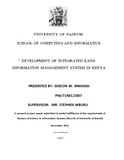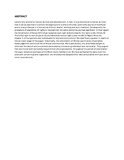Location
Our Vision is to be a world-class university committed to scholarly excellence.
Our Mission is to provide quality university education and training and to embody the aspirations of the Kenyan people and the global community through creation, preservation, integration, transmission and utilization of knowledge.
Core Values
In order to realize the above vision and mission, certain shared values shall be nurtured. There is great need for the University to be guided by the right values derived from the virtues and moral standards of the Kenyan and wider society.
Core Functions
Teaching and Learning: The university offers innovative , relevant and market driven academic programmes , both at undergraduate and postgraduate levels with inbuilt quality control systems the university also provides an environment and policy framework for undertaking high quality and relevant research
Members:
Resources
Displaying 116 - 120 of 298Farmers' ethno-ecological knowledge of the termite problem in semi-arid Nakasongola
Infestation and destruction of rangeland vegetation by subterranean termites is a major constraint to livestock production in the rangelands of Uganda, particularly, in semi-arid Nakasongola. Ethno¬ecological studies on termite dynamics are central to formulation of sustainable termite management strategies in such ecosystems. This study was thus conducted to investigate farmers' traditional ecological knowledge of the termite problem with the intent to build more coherent principles required in the development of appropriate termite management strategies.
Use of Dry Land Tree Species (Prosopis juliflora) Seed Pods as Supplement Feed for Goats in the Arid and Semi Arid Lands of Kenya
Abstract: This study was conducted to determine the potential of incorporating Prosopis juliflora seed pods into typical dry land livestock production systems to minimize feed scarcity during the dry seasons and avoiding weight losses and poor performance. The study evaluated supplementation of weaner Galla goats with increasing amounts of Prosopis juliflora seedpods that is widely distributed in arid and semi arid areas of Kenya. This species is drought tolerant and with high productivity of seed pods whole year round.
Development of integrated land information management system in Kenya
Land is a key asset of any country. It is one of the factors of production which includes labour
and capital. It is critical for economic, social and political development of a country. There exists
a correlation between proper utilization of land and the economic advancement of a country and
its proper management can only be achieved if information on the said land is available. The
current globalization trend in the world, demand for efficient and effective land services requires
The Desert Margins Programme Approaches in Upscaling Best-Bet Technologies in Arid and Semi-arid Lands in Kenya
Kenya’s land surface is primarily arid and semi-arid lands (ASALs) which account for 84% of the total land area. The Desert Margins Programme (DMP) in Kenya has made some contribution to understanding which technology options have potential in reducing land degradation in marginal areas and conserving biodiversity through demonstrations, testing of the most promising natural resource management options, developing sustainable alternative livelihoods and policy guidelines, and replicating successful models.
Regulation of the procedure for acquiring land as a Tool for monitoring land use to attain sustainable Development: A critique
Land is very central for human survival and development. In fact, it is so elemental to human
survival that it can be said that it is where life begins and it is where life ends. Land is the source
of livelihood and to many a Kenyan it is the source of food, shelter, clothing and even medicine.
Consequently the procedure of acquisition of rights or interest over the same cannot be any less
significant.
In that regard the Constitution of Kenya 2010 does recognize such right and provides for the






